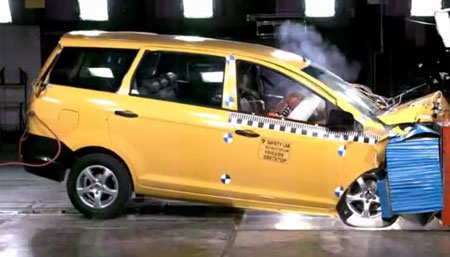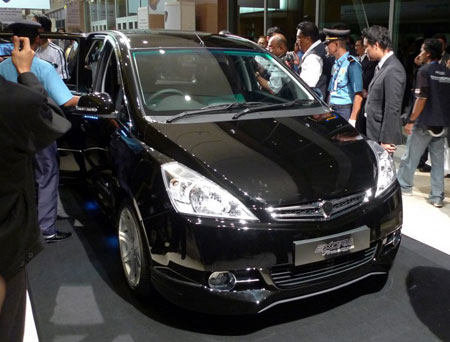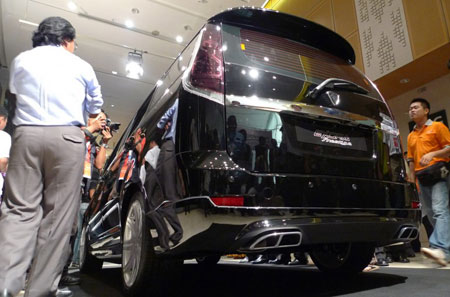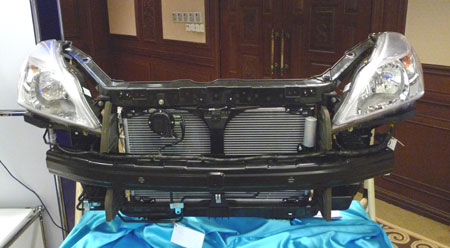
It was a day of many firsts for me, the day Proton corporate communications invited some of us to test drive a prototype of the new Proton Exora MPV. Yup, we got to drive a pair of Exoras, both the same colour but taped up in the typical black disguise that you’ve seen countless of times on the spyshots featured on this site.
We drove 2 prototype units, one with a manual transmission and one with an automatic transmission, from Proton’s plant in Shah Alam along the KESAS highway, then onto the MRR2, Karak Highway, and then the East Coast Expressway, where we made a U-turn at the Lanchang exit and on back to the Proton plant (we stopped at Karak town for awhile). The first half of my journey was in the manual model while the 2nd half was in the automatic model.
Look after the jump for my experiencing with the Proton Exora, as well as some other information gathered from our session with the engineers.

I believe one of the first questions you would like to have answered on the Proton Exora MPV is whether it is underpowered or not. The next would be whether it is spacious inside and comfortable. I will quickly answer these concerns. Bear in mind all of my testing was done with between 6 to 7 people on-board, so I don’t know how the car performs with only 2-3 people in it. I would assume it would be so much better. Comparing kerb weights, you can actually predict that an Exora with only the driver in it would probably feel like a Waja with 4 people in it?
The engine used under the hood is the Campro CPS engine and its CPS and VIM activation parameters are similiar to the unit installed in the Waja CPS and the GEN2 CPS. It is only the Satria Neo CPS which has different CPS activation timing. It produces 125 horsepower at 6,500rpm (7,000rpm redline) and 150Nm of torque at 4,500rpm. I am sure there is still some improvements that can be squeezed out here as a competitor engine can churn out 160Nm of twisting power from a normally aspirated 1.6 liter and the CPS is a long stroke engine which means it should be able to be quite torquey by nature. The gearbox has had its final drive modified to help with the power delivery, and 110km/h RPM on the auto is somewhere between 2,700 to 2,800rpm (cannot remember exactly right now for some reason).
The achilles heel of the Exora is the Campro CPS engine. With the automatic transmission, it is best described as being just enough to move the car, and you can feel the engine being worked really hard to move the MPV, which was loaded up with 7 people. With a kerb weight of 1,380kg, adding all the passengers brings it close to its gross vehicle weight of over 1,900kg. It is seriously no mean feat.
You can truly feel the torque curve of the CPS engine with your butt-o-meter, no measuring devices necessary. Every dip and peak in the curve can be felt because the pace of the MPV’s acceleration depends on every single Newton meter that the engine can churn out. Proton’s famous air conditioning compressor which works great but seems to sap plenty of engine power can already be felt in cars like the GEN2 CPS, but it is even more prominent in this car, slowing things down considerably when it kicks in.
Now the thing is, the only time where acceleration was found to be sluggy to the point of annoyance was when the Exora was starting from a standstill. Not so much in the manual version but it’s quite bad in the auto on even a slight incline. Once it gets going and the Campro engine is in its powerband, things get going sufficiently. I won’t go to the extent of describing it as swift or any similiar words, but I think perhaps 80% of the time and an majority percentage of situations, the Exora has enough power. Most Genting slopes can be taken with 2nd gear in the manual if you have enough momentum, with only the steepest requiring a shift to 1st gear. Mind you, this is according to a Proton engineer as we didn’t climb Genting in our drive.
The manual has more ratios and saps less power. The auto is a little more lethargic and there was one occasion on an incline where it felt really sluggy because I had the pedal to the metal and there was room to do a downshift but it did not! Perhaps there is still some work and finetuning to be done on the TCU? Had to manually downshift via the auto’s gate shifter.

Click to enlarge
I think you can begin to visualise how you will have to drive this. Plan your journey well and look far ahead at traffic as to plan your route through the road’s traffic - minimize braking and keep the momentum up, because once you slow down, acceleration is going to take awhile. Stay out of the fast lane because if you change lanes to overtake, it’s going to take a long time and you might annoy the hell out of cars coming up behind you. I personally drive a car that is quite underpowered as well and for slow and comfortable driving you won’t have issues with the Exora.
Just don’t try to get anywhere in a hurry. Not with your entire family on board anyway - too heavy and not good to endanger them. Also you have to be careful when trying to get across busy crossjunctions or enter busy roundabouts, I foresee that might be a problem with the auto.
On an empty road and ample space for acceleration, the Proton Exora can actually achieve some really high speeds. 140 to 160km/h are no problem given enough time and even beyond that is possible on a downhill stretch. These high speeds can be sustained easily, it is only when you slow down and try to climb back up to those speeds where it takes a long time. Typical Campro and Campro CPS, only shines at the top end, which is why I feel turbocharging with a low pressure turbo will do wonders for it.
Another thing I noticed is how smooth the engine was. It was very loud at high revs approaching the 7,000rpm redline and its boom echoed throughout the interior, but there was not much vibration, something that many current CPS-equipped car owners experience when they send their rev needles to the redline, especially in the Satria Neo. And the engine is pretty docile at regular highway cruise speeds. It’s quite quiet actually. Conversations can be carried out all the way form the front row to the third row without having to raise voices. That is a sign of some pretty impressive sound proofing and NVH optimisation. It remained calm and serene without us having to raise our voices to have a conversation even at speeds of beyond 170km/h. It’s really impressive. Like I mentioned before, the only time the cabin seemed overwhelmed with noise is when the Campro CPS is near the redline. Then you get the boom and blare.

Click to enlarge
The Exora dashboard is probably a first Proton dashboard that does not seem like it is built for midgets in a long long time. It isn’t set too low in the interior. Had no complaints about it so I guess it is at a proper proportionate height. The gear shifter is raised and is very near to the steering wheel so it’s pretty easy to reach for whenever you need to shift gears. The speedo is easy to read and done in white and red.
There is now an instant real-time digital fuel consumption readout but in our prototype vehicles this was not working. It displayed data but was incorrect, with consumption numbers (in liters per 100km) being excessively low most of the time. A Proton engineer told me the prototype car had an old version of some software update and had not been flashed to the latest version yet so the calibration for the instant fuel consumption readout was all wrong. I have a miff with the way you get the meter to display but I will cover this in a later story.
I was happy with the position of the steering wheel. It isn’t too far away. Near enough for me to have a comfortable and firm grip. The seat could be pushed back as far as I required (I am 182cm tall) and I even tried pushing it completely to the rear, but there was still a seriously large amount of legroom in the 2nd row. The driver’s seat was slightly elevated and offers a SUV-like commanding view of what’s ahead. The Proton Exora was stable and planted for as fast as I drove, which is only up to about 160km/h at one point. The fastest I went most of the time was only 140km/h, if I recall correctly. I didn’t dare speed further than that actually as there were 6 other people in the MPV with me, I didn’t want to risk anything.
The steering has a nice weight to it and is easy to keep steady through negotiating a corner. It was precise too, pointing the nose of the car exactly where you expect it to go. No complaints about the brakes and there was also minimal brake dive. The Exora can be ever slightly floaty at times depending on how undulating the terrain is but I found that I only felt this as the driver, didn’t notice it as a passenger.

Click to enlarge
I drove more like a typical MPV driver would, but as a passenger I witnessed some pretty mad cornering around the Karak curves at speeds of 120 to 140km/h without the Goodyear Assurance tyres even making much of a fuss. As usual, the Proton boys have got the car’s ride and handling close to perfect. One of the most impressive things about the MPV is the fact that the third row felt as chill as the 1st or 2nd row, just that it has less space. At this price level or even much more expensive than the RM70k to RM80k that the Exora is expected to be priced at, you usually get a third row that is quite uncomfortable when the vehicle is on the go, because of its position right over the vehicle’s rear axle. It’s usually quite bumpy and headroom is sometimes limited. The Exora trumps all its competition at this.
The third row is so comfortable compared to the bouncy stuff you get with other cheap MPVs and even when one fellow journalist was whacking the corners at high speeds, I didn’t feel thrown around or dizzy. When the Proton Exora travels over an irreguliarity in the road such as the usual place where 2 different pieces of an elevated highway joins together during a corner, the rear end of the car remained composed and calm. Other MPVs would swing and bounce around, creating discomfort for the third row. There are air cond vents for all 3 rows, and the rear rows get its own dedicated blower located in the space above the rear left wheel. The fuel filler is on the other side of course. The rear ceiling vents also have their own blower speed control mounted on the ceiling. Air conditioning for 2nd and 3rd rows is really best in class and the vent angles can be adjusted easily.
Now that we have the Proton Exora’s engine, handling and comfort nailed down let’s talk about space and later proceed to usability/ease of use. As previously mentioned, there is plenty of second row space. Both the 2nd and 3rd row have the ability to have their seat recline adjusted. The third row backrest and seat angle moves together when you adjust its reclining position to maintain a comfortable hip point. For me to fit in the third row requires the 2nd row to be a little more straight up than the optimum comfortable position. That way I can fit comfortably with only the cloth of my pants barely touching the 2nd row seat back.

Third row legroom - I am 182cm tall
I didn’t really feel like I was sitting on the floor of the Proton Exora though my knee was higher than usual and it was impossible to do any form of leg stretching, but get into the third row of an Exora from a competitor and you’ll feel relieved. There is also plenty of headroom for all 3 rows. Headroom is seriously aplenty here. It makes it easy to get into the third row as you do not have to bend down too much. The third row is going to be seriously comfortable for kids. With the third row fully reclined, the seatbacks are pretty much very close to the rear glass. Luggage space is limited to the triangular-shaped area between the seatback and the floor, which fits 1 golf bag and a few other small items. If you make the third row seatback a little more straight up, you create more luggage space, but it’s not going to be very comfortable for adults at all. The M-Line also lacks any headrests for the third row so it could touch the rear glass sometimes.

Third row headroom - I am 182cm tall
The second row of the Proton Exora has no sliding ability. But what it can do is tumble-fold completely forwards, creating an empty space in the area where the 2nd row is. This makes it quite easy to get into the third row. The 2nd row seats split 60:40 and the tumbling mechanism can be done independently of each other. The tumbling mechanism works via pulling a strap - from what I understand you pull it a little and it folds down once, pull it completely and it tumbles completely forward against the first row seatback. As I previously mentioned, there is quite alot of space in the 2nd row. Perhaps some of that space should have been allocated in improving some of the third row space. When I suggested this, a part of the Proton team gave an answer that makes sense somehow. Proton wanted the MPV to feel big, spacious and comfortable. It is the number one selling point for an MPV and an MPV has to do that well for it to be considered a good MPV. Not handle well or outrun a sports car. So what they did was make sure at least 5 out of 7 people in the MPV enjoy a great experience. Not 7 people enjoying a mediocre experience.
A convenient teh tarik hook is located in the lower area of the dash near the front passenger footwell, and the front seats have some hooks at the back of them for 2nd row usage as well. There are plenty of cupholders and bottleholders, even for the third row.
One main pet peeve I have is that NONE of the Exora variants destined for Malaysia have ISOFIX points, not even a single one in the Exora. When I asked the engineers about this, the reason given was cost and the lack of regulations requiring ISOFIX points in Malaysia. Personally I feel as a national car company which gets plenty of incentives from the government and is government-owned, safety for the rakyat and future leaders of the nation should be at least given priority! Not just airbags, etc. You harp on the necessity to have seatbelts and force people to wear belts in all seats, so why deny children the safety of a properly fixed child seat? I know this isn’t up to the engineers and decide and from what I know they have no problems implementing this, so it is more of a product planning decision.

AA surveys show that child seats that are fitted with the adult seatbelts are typically 70% to 80% misfitted with around 30% being seriously misfitted. So what happens during an accident or harsh braking? Your child might just fly together with the misfixed seat! When even the Satria Neo has ISOFIX points, why not in the Exora? if you say lack of regulation requirements - then why are they in the Neo? Cost, how much can ISOFIX points cost! RM50 to RM100 per point? A maximum of RM500 per car, with overly inflated costs for 2 ISOFIX-equipped seats in the 2nd row? Couldn’t scrapping some of your Corporate Social Responsibility programs cover the cost of proper ISOFIX points in your Exora? Spend the money on your real customers instead of others!
Why wait for the government to enforce something? Proton should be proactive in taking this step. Malaysians are not educated on such safety features. Do your part in educating them. Perhaps in your focus group studies for the Exora, none of the potential customers asked for ISOFIX points because they don’t even know what ISOFIX is. That is no reason for you to omit them. Put them in and educate them. Don’t be penny-wise pound-foolish. The good PR from this will be valuable, more than the cost of the points themselves. Really good child seats with ISOFIX support can be expensive. Package them together with your hire purchase loans for families to be able to afford them.
Do it, and do it soon. Showing that you are concerned about your customers will do wonders for your image. Then move on later to more than just 2 front airbags, and perhaps some form of stability and traction control. Dual SRS airbags should really be made standard. I hope there are people in the Proton management/product team reading this.
The Proton Exora MPV is a very impressive product on the overall, and even more so when you take into account its expected price level. It’s got best in class interior room and can be compared to vehicles that are on class above. It can move a whole family along in comfort, just that it is slow in getting moving. I know it sounds like I’m making excuses for Proton but from my own personal driving experience there were only certain times when I felt it was underpowered. Given that most of our drive was on the highway, most of the situation we only had to get up to cruising speed once and the Exora maintained its speed well. It’s just too bad that Proton has no powerful engine to put in it at this point and has to compromise with the Campro CPS as the sole option. It’s fine as a very baseline engine but it really cannot be the only option. Hope that’s fixed with the Campro Turbo.
The lack of certain features such as ISOFIX points in the Malaysian version in no way cripples the ability of the Exora to be a fine MPV of course but it reflects the still on-going shortchanging that Malaysian consumers always seem to get, because from what I was told, ISOFIX will be in the export cars. In fact these are only the very few things that I have to complain about, the MPV does its MPV duties really well and I am impressed at how Proton engineers really got it right the first time.
Anyway forgive me for the lack of photos from the actual test drive session. We weren’t allowed to use any photos actually and had to get photos approved on a case by case and photo by photo basis with justification. Whatever photos I justified using are already in this story. I must thank Proton especially their corp comm team and engineers for organising a well-planned and extremely informative test drive session. More to come - some juicy details on some various new features and specs of the Proton Exora including the BCM module.
 Malaysian Prime Minister Dato` Sri Mohd Najib bin Tun Abdul Razak has officially launched the much anticipated Proton Exora, Malaysia’s first home-grown multi-purpose vehicle (MPV) last night.
Malaysian Prime Minister Dato` Sri Mohd Najib bin Tun Abdul Razak has officially launched the much anticipated Proton Exora, Malaysia’s first home-grown multi-purpose vehicle (MPV) last night.
































